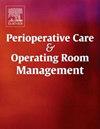Intraperitoneal installation of bupivacaine with either dexmedetomidine or ketamine for postoperative analgesia after laparoscopic sleeve gastrectomy: A randomized controlled study
IF 1
Q2 Nursing
Perioperative Care and Operating Room Management
Pub Date : 2025-02-05
DOI:10.1016/j.pcorm.2025.100481
引用次数: 0
Abstract
Background
Postoperative pain management after laparoscopic sleeve gastrectomy is still considered a major challenge. The current study was designed to assess if adding ketamine or dexmedetomidine to intraperitoneal bupivacaine could improve the quality and the duration of postoperative analgesia for morbidly obese patients undergoing laparoscopic sleeve gastrectomy.
Methods
Sixty patients scheduled for elective laparoscopic sleeve gastrectomy were randomly assigned to receive intraperitoneal instillation of bupivacaine (0.25 %) alone (group C), bupivacaine (0.25 %)/ketamine 0.5 mg/kg (group K) or bupivacaine (0.25 %)/dexmedetomidine 1µg/kg (group D) after sleeve gastrectomy. The primary outcome measured was the time to first postoperative rescue analgesia. Secondary outcomes included postoperative analgesic requirements, postoperative pain intensity measured by the Visual Analog Scale (VAS) and the incidence of shoulder pain.
Results
The time to first rescue analgesia was significantly longer (< 0.001) and the total amount of postoperative nalbuphine required was significantly lower in both the K and D groups (< 0.001) compared to the C group. Additionally, the time to first rescue analgesia was significantly longer in group D compared to group K. The VAS score was significantly lower in groups K and D compared to group C (P < 0.05) at most measuring points, with no significant difference between groups K and D. The incidence of postoperative shoulder pain was significantly higher in group C compared to groups K and D (< 0.001) with no statistically significant difference between groups K and D.
Conclusion
Adding either ketamine 0.5 mg/kg or dexmedetomidine 1µg/kg to intraperitoneal bupivacaine 0.25 % can safely improve postoperative analgesia resulting in a longer time to first rescue analgesia, lower VAS for pain values, reduced postoperative rescue analgesic requirements in the first postoperative 24 h and a lower incidence of postoperative shoulder pain.
布比卡因与右美托咪定或氯胺酮腹腔注射用于腹腔镜袖胃切除术后的术后镇痛:一项随机对照研究
背景:腹腔镜袖胃切除术后的疼痛管理仍然被认为是一个主要的挑战。本研究旨在评估在布比卡因腹腔注射中加入氯胺酮或右美托咪定是否能改善病态肥胖患者腹腔镜袖式胃切除术后的镇痛质量和持续时间。方法选择60例择期腹腔镜套筒胃切除术患者,随机分为两组:单用布比卡因0.25% (C组)、套筒胃切除术后布比卡因0.25% /氯胺酮0.5 mg/kg (K组)或布比卡因0.25% /右美托咪定1µg/kg (D组)。测量的主要终点是到术后第一次抢救镇痛的时间。次要结局包括术后镇痛需求、用视觉模拟量表(VAS)测量的术后疼痛强度和肩痛发生率。结果第一次抢救镇痛时间明显延长(<;0.001), K组和D组术后所需的纳布啡总量均显著降低(<;0.001),与C组相比。此外,D组首次抢救镇痛时间明显长于K组。K、D组VAS评分明显低于C组(P <;C组术后肩痛发生率明显高于K组和D组(<;结论在0.25%布比卡因腹腔注射中添加氯胺酮0.5 mg/kg或右美托咪定1µg/kg均可安全改善术后镇痛,使患者首次抢救镇痛时间延长,疼痛VAS值降低,术后首24 h抢救镇痛需求减少,术后肩关节疼痛发生率降低。
本文章由计算机程序翻译,如有差异,请以英文原文为准。
求助全文
约1分钟内获得全文
求助全文
来源期刊

Perioperative Care and Operating Room Management
Nursing-Medical and Surgical Nursing
CiteScore
1.30
自引率
0.00%
发文量
52
审稿时长
56 days
期刊介绍:
The objective of this new online journal is to serve as a multidisciplinary, peer-reviewed source of information related to the administrative, economic, operational, safety, and quality aspects of the ambulatory and in-patient operating room and interventional procedural processes. The journal will provide high-quality information and research findings on operational and system-based approaches to ensure safe, coordinated, and high-value periprocedural care. With the current focus on value in health care it is essential that there is a venue for researchers to publish articles on quality improvement process initiatives, process flow modeling, information management, efficient design, cost improvement, use of novel technologies, and management.
 求助内容:
求助内容: 应助结果提醒方式:
应助结果提醒方式:


